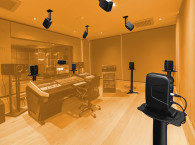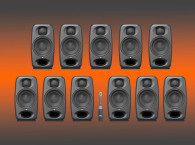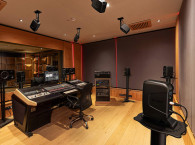This single-box acoustic correction solution from IK Multimedia targets home studio needs and stereo system users, seeking playback chain improvements. Will it work at home as in the studio?
DSP-based room and speaker correction has become a widely accepted method for improving room acoustics as a measure besides conventional acoustic treatment. While the concept of implementing a DSP in the playback chain sounds straightforward in theory, in practice, the devil is in the details.

“Where to actually implement the DSP in the signal flow?” is a question that robbed plenty of studio owners of their night’s sleep. Put it in the PC, audio interface, a separate processor or in the speakers itself? There is a product available for all these approaches. Why is there so much variety?
Pure software-based room correction in Windows and macOS applied to the overall system output often still feels like a “hack.“ This has improved a lot in the last years, but one cannot be sure if audio is reliably processed and what is happening under the hood. When the processing is done through a plug-in in a DAW, the correction path must be turned off for bouncing, which is an additional task in the busy daily production routine. If, on the other hand, the DSP is in the A/D/A, unwanted latency in recording situations can be introduced. On top of that, auxiliary sources (e.g., for referencing content or analog sources) cannot be corrected. When the room correction is in the speakers, the listening experience is bound to only these speakers, and other speaker sets cannot be used with the DSP inside the speakers. Having a separate DSP for every speaker is, in many cases, excessive and costly. For in-wall mounted speakers, a USB or Ethernet service connection can be an awkward proposition.
For many studio and stereo listening setups the best solution is actually a dedicated processing box, located between monitoring control and the speakers. One can be sure that IK Multimedia had these thoughts played through when they conceived the ARC Studio hardware (Photo 1). Its present product line-up also includes correction in the speaker (iLoud) and software-based solutions (ARC).

What Is the ARC Studio?
The software-based room correction solution ARC (ARC stands for Advanced Room Correction) has improved a lot over the last few years in many aspects and is now in its fourth generation. With this current release, the software became so mature that its processing core is now deployed on a dedicated hardware DSP and marketed as the ARC Studio. The filter calculation code is now a genuine design by IK Multimedia and is no longer provided by Audyssey.
Implemented into a small metal box, the ARC Studio is a standalone room EQ processor, suppressing room resonances and correcting certain speaker deficiencies. An additional speaker simulation mode allows users to hear through other popular speaker sets. This feature might seem superfluous to home listeners but is very handy in production environments to check if the musical message “comes across.“ ARC Studio must be only connected to the PC for initialization and can later be used standalone. IK offers several tiers of the ARC plug-in solution and ARC Studio, including their ARC measurement MEMS mic in the package or not.
User Experience
The install process leads over an e-mail registration and a download manager software, available for macOS and Windows. It took only 10 minutes to install. Registration of the license was done in seconds.
Another necessary evil, the inevitable firmware upgrade was quickly done, too. After the installation, there can be two new apps found: ARC 4 analysis and ARC 4. ARC Analysis is for the measurements. Fine-tuning and setup is done through ARC 4. To create a room correction profile, an audio interface with +48V phantom power must be used for the measurements with the MEMS mic (Figures 1-4). Once the measurements are done, the device can be theoretically stowed away. Remote control is always possible through the USB-C connection. The last mode is saved and does not have to be switched on (or off) manually in a new power cycle. ARC does not support surround format encoding or processing. Since there is already an Atmos target curve available and a home theater measurement preset can be found, I am hopeful that future releases include surround formats support.




Hardware and Spec Check
The ARC Studio is a small and lightweight metal box. In fact, it is so lightweight that the four connected XLR cables let the box tip over backward and tail-strike. To my surprise, it cannot be used as a D/A converter when connected through USB-C to the computer. Also, USB-C cannot be used to power the unit. Three self-explanatory LEDs on the front panel give an overview of the status. The main indicator for room correction is orange when it is ON and off when it is OFF. I feel that this is a bit confusing, since orange is hard-wired to bypass in my brain.
The included switch-mode power supply (SMPS) wall wart is called “iRig“ and must be used at all times. An IEC connector and integrated PSU are much preferred but would have certainly added cost. No cost-cutting has happened with the XLR connectors: The Neutrik jacks are screwed tightly to the housing and will withstand several plug/unplug cycles.
During testing, the box became quite warm with 35°C/95°F surface temperature. The power draw was at a constant 6W, certainly caused by high-quality op-amps from NJR (Photo 2). The measurement with a 1kHz sine confirmed IK‘s claimed specs of 107dB THD+N (Figure 5). At +10dBV the ADC got overloaded. The AC mains noise is practically non-existent in the audio signal. Using white noise as stimulus, the claimed internal sample rate of 96kHz can be confirmed and at frequencies higher than 48kHz, we are presented with a properly designed reconstruction filter (Figure 6) with a high stopband rejection rate.


In the ARC 4 software, the user can choose between a natural and linear phase mode. Natural comes with a 1.4ms (0.6m/2ft), linear with 44ms (15m/49.7ft) latency. The latency does not change when the processing is bypassed (Figure 7 and Figure 8). In my listening tests, I preferred the natural phase mode over linear, since linear sounded a bit harsh, more processed, and blurred in the midrange. The frequency response with the processing bypassed is ruler flat (Figure 9).



In-Room Results
To put the small DSP processor through its paces, I decided to correct my office with it. I use a pair of Neumann KH310A as my main speaker system here. This room is especially hard to tame, as it is almost square and with 10m2/107ft2 relatively small. With some acoustic treatment, I was able to bring the RT60 down to about 350ms broadband average. A massive boost at 52Hz and several boosts between 100Hz to 150Hz must be dampened through the room EQ. The ARC software quickly detected these areas and improved the in-room sound quality significantly (Figure 10). The typical faults of auto-tuning systems could not be observed. If a certain correction filter is not wanted, it can be corrected in the editor. This way overcompensation in the low-end can be avoided.



Conclusion
The ARC Studio covers an interesting middle ground between high-end hardware-based room correction and software-based solutions. Its components are shown in Photo 3. And I have included my own pros and cons list regarding the unit. Overall, with very little artifacts added to the played back sound, it can be a worthwhile investment, while the price point is more than fair! It retails at USD $300/EUR €349. And all that for a product made in Italy!

From what I have seen in test time, the ARC Studio behaves well, and results are reproducible. As IK Multimedia is primarily targeting musicians and home studios with its products, the ARC Studio is also located in this realm. Home listeners can profit too, presuming they are proficient with the use of audio interfaces. I hope IK Multimedia finds success with the ARC Studio and iterates into the next version soon. aX
IK Multimedia ARC Studio Pros and Cons
Pros:
Clean and efficient processing and transparent audio pass-through
Great middle ground solution between auto calibration and manual control
Unique problem solver
Ease of use and setup
Clear scope: crafted around home studio needs
Cons:
Wall wart type power supply (switch mode)
Registration with e-mail-address needed for software download
Speaker presets cannot be switched on the faceplate of the box
No bus-power or digital-to-analog conversion via USB-C
Resources
S. Yaniger, “IK Multimedia ARC 2.5 MEMS Test Microphone,” audioXpress, March 2018,
https://audioxpress.com/article/fresh-from-the-bench-ik-multimedia-arc-2-5-mems-test-microphone
R. Tipton, “IK Multimedia ARC 2.5 Advanced Room Correction System,” audioXpress, March 2018,
https://audioxpress.com/article/fresh-from-the-bench-ik-multimedia-arc-2-5-advanced-room-correction-system
This article was originally published in audioXpress, August 2024






